October 2, 2022 – I am not sure if I am holding my own on pre-winter projects, deluding myself or accepting all will not get done.
The remaining yard or two of compost, for months conspicuous under a big blue tarp, finally became topping on the lawn; a little tractor work, a bit more shovel work and a lot of raking in. Grass seed was put down, a special blend of cheap and plentiful. I have visions of a bright green lawn emerging from beneath the spring snow melt. Always do. Never does.
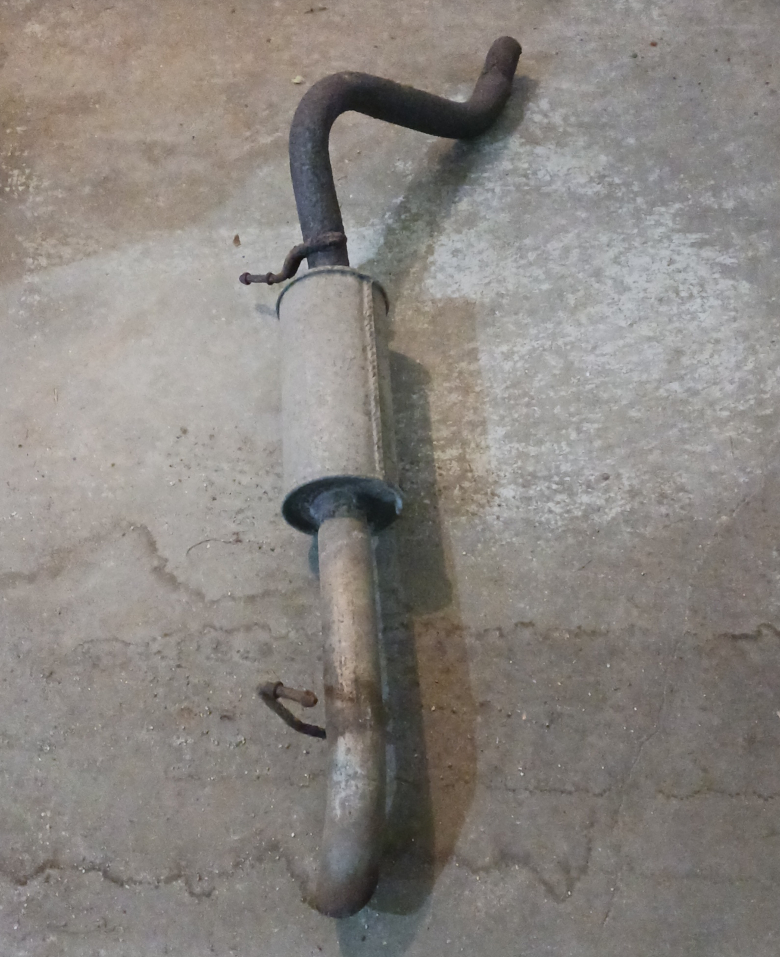
The final piece in the thrasher Ford Escape exhaust system puzzle was located, the rear catalytic converter. Odds on, the repair can be made with minimal down time, so disassembly commenced; tailpipe and resonator today, cat and muffler tomorrow after a flange bolts soak in Kroil.
I am going to miss that thrasher. Looking around underneath, while it doesn’t show up top, a couple more years and rust will put it out of commission. Wouldn’t it be nice to be able to pick a handful of things that would always remain the same, need no maintenance and would last a lifetime?
What follows is a handload development project where I spend a good deal of time asking myself questions and responding with few answers. Sometimes thinking is the most helpful activity.
The return of the 450 Bushmaster to Real Guns
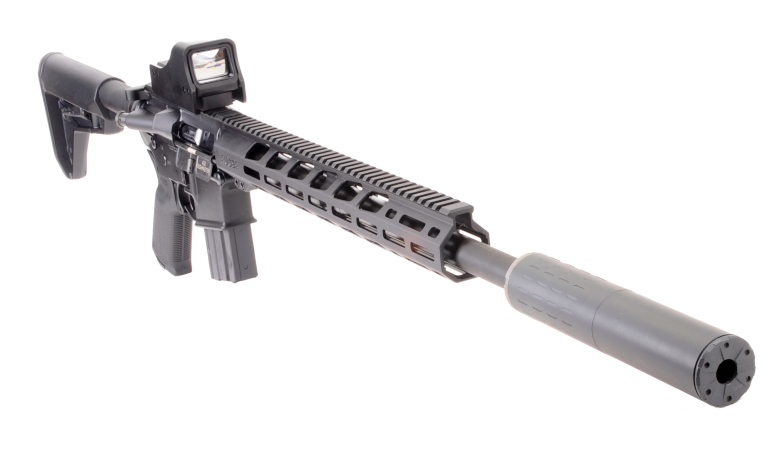
The 450 Bushmaster has appeared on the pages of Real Guns in both semi auto, like the Ruger AR-556 in 450 Bushmaster, and bolt action firearms. Both types appearing with multiple handload data sets. Both types were loaded to the SAAMI 38,500 psi MAP and over pressure, as labeled, for a specific bolt action application.

The 450 Bushmaster brought a few things to firearm enthusiasts. The first is large deer and elk size game capability to the AR15. Yes, I know there are others.
The 450 Bushmaster also offered a considerable amount of power to hunters in states that place a straight case wall restriction on centerfire cartridges permitted for hunting. Yes, I know there are others.
Finally, for folks who hunt with suppressed firearms, velocity needs to stay well under 1150 fps to be optimally subsonic. Subsequently, bumping power comes from lobbing the heaviest weight bullet possible without exceeding the speed of sound.
Hornady offers a factory 395 grain subsonic load, 1050 fps, that is recommended for use on medium size game, 50 – 300 lbs. Looking at Hornady’s published external ballistics, for me, this would be a 100 yard cartridge, which fits many applications.
In total, there are 7 brands contributing to a combined 16 factory loads. Bullet weights range from 220 grain to 395 grains. No, not exactly overwhelming retailers’ shelves, but a whole lot better than peer cartridge attempts that were announced and then almost immediately went extinct.
Comparatively speaking…
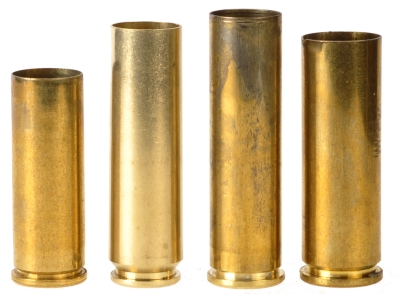
| Cartridge | Capacity Grains H2O |
SAAMI Maximum Average PSI |
SAAMI Standard Bullet Weight |
SAAMI Standard MV fps |
SAAMI Test Barrel Length “ |
| 454 Casull | 46.8 | 65000 | 260 | 2000 | 9.3 |
| 450 Bushmaster | 60.0 | 38500 | 260 | 2150 | 24.0 |
| 460 S&W | 60.0 | 65000 | 260 | 2150 | 10.0 |
| 500 S&W | 63.5 | 60000 | 300 | 2050 | 10.0 |
The purpose of the table is to place the 450 Bushmaster into context with cartridges of similar performance. Which is not easy to do as, presented by each respective manufacturer, pressures vary, barrel lengths vary and at least one differs in bullet diameter.
With 60+ grains of powder capacity, and lots of pressure, the 460 S&W and 500 S&W cartridge could benefit significantly from longer barrel length. So, Joe, should you not represent each with a common barrel length to be fair and give all of them a trophy. No.
The table places the cartridges in their natural habitat, loaded into revolvers, with the exception of the 450 Bushmaster. The Bushmaster was designed as a rifle cartridge, but it would rarely be assigned a 24″ barrel. The way we are dealing with that non-standard standard, is to chronograph with a 18″ barrel rifle as a typical 450 Bushmaster.
What to do? What to do?
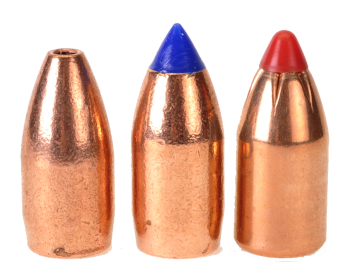
Usually, handloading the Bushmaster for AR or bolt action platforms, often involves sourcing 0.451″ or 0.452″ bullets designed to reside in muzzleloader sabots, ahead of 200 grains of black powder. Why?
The bullets have adequate toughness to endure and expand at 450 Bushmaster velocity levels and they have a relatively high ballistic coefficient to help the retain velocity over the longer haul. What longer haul? Exactly.
Short Bullet – Long Bullet Conundrum and why should you care
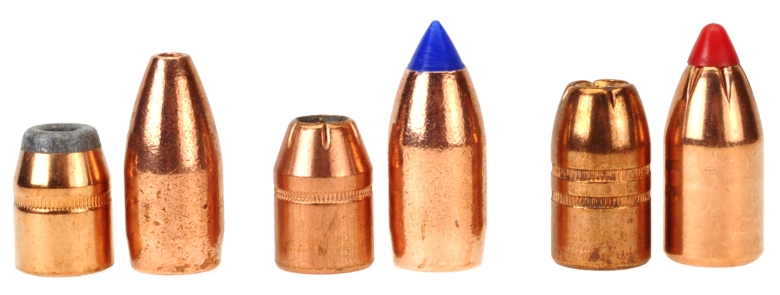
Above: 240, 250 and 300 grain sets of handgun versus longer, higher ballistic coefficient from Barnes and Hornady. How much difference does shape and BC matter at 100 yards?
| 250 Grains 0.150 BC | ||||||||||||
| Yards | 0 | 10 | 20 | 30 | 40 | 50 | 60 | 70 | 80 | 90 | 100 | |
| Velocity – fps | 2100 | 2048 | 1997 | 1947 | 1898 | 1849 | 1801 | 1754 | 1707 | 1662 | 1618 | |
| Energy – ft.-lbs. | 2448 | 2328 | 2214 | 2104 | 1998 | 1897 | 1800 | 1707 | 1618 | 1533 | 1452 | |
| Momentum – lbs-sec | 75 | 73 | 71 | 70 | 68 | 66 | 64 | 63 | 61 | 59 | 58 | |
| Path – in. | -1.50 | -0.63 | 0.16 | 0.86 | 1.47 | 1.99 | 2.40 | 2.70 | 2.90 | 2.97 | 2.91 | |
insert pictures of rifle top and bottom
SKU 08522
| 250 Grain 0.210 BC | ||||||||||||
| Yards | 0 | 10 | 20 | 30 | 40 | 50 | 60 | 70 | 80 | 90 | 100 | |
| Velocity – fps | 2100 | 2063 | 2026 | 1990 | 1954 | 1919 | 1884 | 1849 | 1814 | 1781 | 1747 | |
| Energy – ft.-lbs. | 2448 | 2362 | 2279 | 2198 | 2119 | 2043 | 1969 | 1897 | 1827 | 1760 | 1694 | |
| Momentum – lbs-sec | 75 | 74 | 72 | 71 | 70 | 69 | 67 | 66 | 65 | 64 | 62 | |
| Path – in. | -1.50 | -0.65 | 0.13 | 0.81 | 1.41 | 1.92 | 2.33 | 2.65 | 2.86 | 2.97 | 2.97 | |
Difference of little consequence – Practically speaking, at 100 yards, there is not a difference of consequence in a hunting setting. If distances were longer, the higher BC bullets would continue to pull away with higher retained velocity and corresponding kinetic energy. But the intended setting isn’t long range, it is inside 100 yards… and probably less. Not powder burn close, but close.
Broader selection – Using handgun bullets, appropriate for 450 Bushmaster velocity, the typically very restricted selection of bullets made specifically for the 450 Bushmaster is appended with a wide variety of bullet types made for cartridge like the heavy loaded 45 Colt, 454 Casull and 460 S&W.
Cost – The handgun bullets used within this project, at 36¢ per, are 1/3 rd to 1/5 th the cost of the the longer, high ballistic coefficient bullets. For some, cost may not be a factor. Personally, I handload and shoot a good deal so component consumption cost adds up quickly.
Putting handgun bullets in all the wrong places…
My intention, at least before lunch, is to assemble a bunch of handloads with the bullets seen below. Well, maybe not the specific bullets shown below, but some near identical facsimiles, and shoot them through a Ruger AR-556 450 Bushmaster’s 1:16″ rate of twist barrel.
The rate of twist is comparatively tight, as most 0.451″ rifles based on the 45 Colt or 454 Casull normally receive much slower twist rates. Something on the order of 1:26″ or 1:30″. So this is where the challenge is made bullets will be subjected to exceptional rotational speed, where centrifugal force will find every bullet’s internal imperfections and scatter groups to the wind.
I don’t think so, as they will see moderate forward and spin velocity not much more than the spin cycle on a washing machine. I don’t know as yet… actually I do since I have finished the project and I am writing from my notes, but let’s pretend I don’t and we can all be held in suspense.
Additionally, I am going to shoot that hard cast… yes, that guy on the end, through a suppressor, even though I know the manufacturer and silencer users world wide will not like it. Why the act of instructional defiance? Because every time I bore scope a silencer to check for lead deposits, with the exception of 22 rimfire applications, I find none.
Lead residue may not show because cast is not shot as a steady diet. Could be lead hardness or the use of gas checks. Could also be the muzzle pressure generated by some of my handloads. Hey, if you want to break a few eggs, scrambled need to appear on the menu.
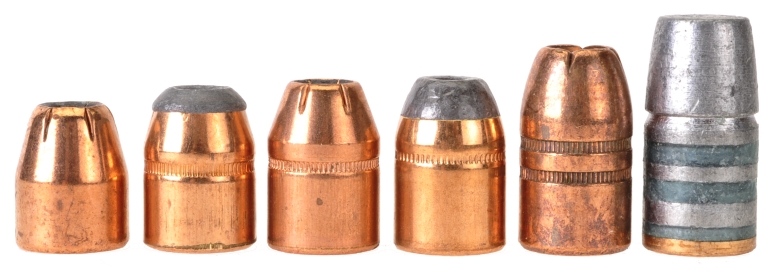
I will now ask the above subjects, left to right, to step forward and tell us something about themselves. Then I will do some elementary school math and see if each can be assembled within 450 Bushmaster overall cartridge length parameters. Too short and they won’t feed or chamber correctly. Too long and… well, pretty much the same thing.
| Bullet | Type | Weight Grains |
Length “ | Depth to Cannelure |
Final COL |
| Hornady HP/XTP | JHP | 200 | 0.567 | *0.250 | 2.015 |
| Sierra | JHC | 240 | 0.643 | 0.340 | 2.000 |
| Hornady HP/XTP | JHP | 250 | 0.665 | 0.345 | 2.020 |
| Speer | JHP | 260 | 0.685 | 0.365 | 2.020 |
| Hornady | XTP/Mag | 300 | 0.808 | **0.310/0.430 | 2.200 |
| Cast Performance | WNFP | 360 | 0.933 | 0.540 | 2.100 |
| * No cannelure. Bullet configured for 45 Auto with taper crimp. ** Dual cannelure, seated to 0.310″ | |||||
They work even better as parts of an assembly…
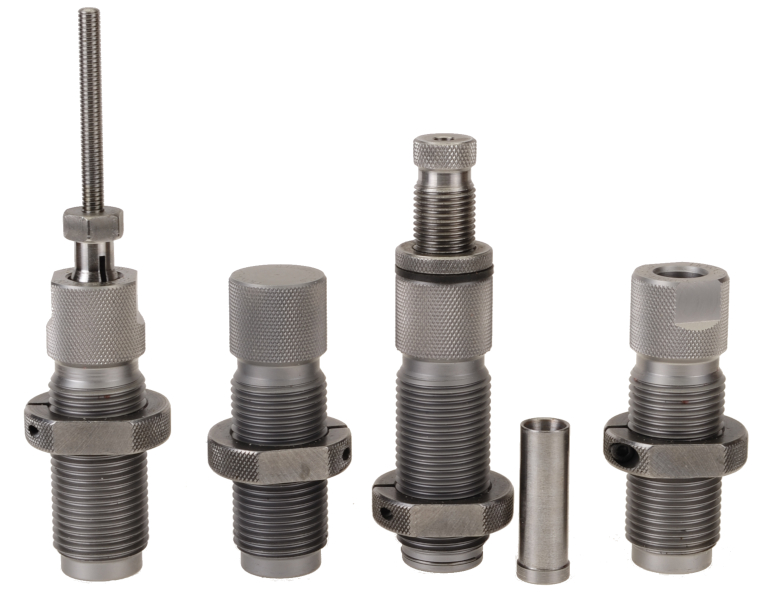
A couple of comments on reloading die setup. Comment-Comment. Kidding. The die set is Hornady brand. The sizer is full length. I do use the expander die, which eases assembly and does not ruin cases unless there is an attempt to turn them into tiny trumpets.
The bullets are all flat nose, so a flat nose seater plug was inserted in place of a conical plug.
Far right, a taper crimp was applied to the Hornady 200 grain HP/XTP, which properly engages the bullet. In addition, all other bullets received a roll crimp and then a light hit with the taper crimp die to assure clean feeding with the autoloader and a headspace contact surface.
Preliminary Results for reference only – Not for use as yet
Warning: Bullet selections are specific, and loads are not valid with substitutions of different bullets of the same weight. Variations in bullet length will alter net case capacity, pressure and velocity. Primer selection is specific and primer types are not interchangeable. These are maximum loads in my firearms and may be excessive in others. All loads should be reduced by 5% as a starting point for development where cartridges have greater than 40 grains in capacity and 10% for cartridges with less than 40 grain capacity following safe handloading practices as represented in established mainstream reloading manuals. Presentation of these loads does not constitute a solicitation for their use, nor a recommendation.
I usually don’t publish preliminary reload data. However, these were close enough that their presence and cautions allow me to share more of a work in process.
| Preliminary 450 Bushmaster – Standard Pressure |
|
| Firearm | Ruger AR-556 MPR 450BM |
| Barrel Length | 16.10″ |
| Max Case Length | 1.700″ +0.000″/-0.010″ |
| Min – Max COL | 2.000″ – 2.260″ |
| Primer | CCI 450 – Small Rifle Magnum |
| Bullet Diameter | 0.4525″ +0.000″/-0.0030″ |
| Reloading Dies | Hornady |
| Bullet Type | Bullet Weight Grains |
Net H2O Grains Capacity |
COL” | Powder Type | Powder Charge Grains |
Muzzle Velocity fps |
Muzzle Energy ft/lbs |
| Hornady HP/XTP | 200 | 49.5 | 2.015 | Alliant 2400 | 37.0 | 2330 | 2412 |
| Hornady HP/XTP | 200 | 49.5 | 2.015 | IMR 4227 | 43.5 | 2290 | 2329 |
| Hornady HP/XTP |
200 | 49.5 | 2.015 | RS Enforcer | 40.0 | 2390 | 2537 |
| Sierra Sports Master | 240 | 46.5 | 2.000 | Alliant 2400 | 33.5 | 2152 | 2469 |
| Sierra Sports Master | 240 | 46.5 | 2.000 | Hodgdon H110 | 41.00 | 2134 | 2427 |
| Sierra Sports Master | 240 | 46.5 | 2.000 | IMR 4227 | 40.5 | 2165 | 2499 |
| Hornady HP/XTP | 250 | 45.4 | 2.020 | RL 7 | 44.0 | 2041 | 2313 |
| Hornady HP/XTP | 250 | 45.4 | 2.020 | Hodgdon H110 | 40.0 | 2232 | 2766 |
| Hornady HP/XTP | 250 | 45.4 | 2.020 | IMR 4227 |
39.0 | 2070 | 2379 |
| Speer Uni-Cor | 260 | 45.8 | 2.020 | Alliant 2400 | 32.0 | 2036 | 2394 |
| Speer Uni-Cor | 260 | 45.8 | 2.020 | Alliant RL 7 | 44.0 | 1873 | 2026 |
| Speer Uni-Cor | 260 | 45.8 | 2.020 | IMR 4227 | 39.0 | 2073 | 2482 |
| Hornady XTP/Magnum | 300 | 47.1 | 2.200 | Alliant RL7 | 43.5 | 1990 | 2639 |
| Hornady XTP/Magnum | 300 | 47.1 | 2.200 | IMR 4227 |
38.0 | 1961 | 2562 |
| Hornady XTP/Magnum | 300 | 47.1 | 2.200 | IMR 4198 | 41.5 | 2001 | 2668 |
| Hornady XTP/Magnum | 300 | 47.1 | 2.200 | Trail Boss |
12.5 | 1006 | 694 |
| Cast Performance |
360 |
38.4 | 2.100 | Alliant 2400 | 27.5 | 1714 | 2349 |
| Cast Performance |
360 |
38.4 | 2.100 | Hodgdon H110 |
34.0 | 1917 | 2938 |
| Cast Performance |
360 |
38.4 | 2.100 | IMR 4227 |
33.5 | 1784 | 2545 |
| Cast Performance |
360 |
38.4 | 2.100 | Trail Boss |
11.0 | 1013 | 820 |
| Blue denotes compressed charges. Red denotes excess pressure and will be dropped = Posted for reference only. |
|||||||
The table above is preliminary data that will be screened and adjusted prior to accuracy, precision, testing for Part II conclusions. In particular, H110 loads were not filled to capacity which is something to avoid with H110. So further assessment is needed.
No adjustment was made to the rifle to accommodate subsonic ammunition and assure proper cycling. I will make some adjustments to see if I can get both load levels working reliably. If that isn’t achievable, I will probably move the data to the bolt action version and either drop it from here or leave it with a footnote and let other take a run at the problem.
I have not yet decided if I will stay with crimps as applied or adjust bullet seating depth so the taper crimp is over a solid section of bullet shank and go solely with a tapered crimp. Having a reliable contact surface at the case mouth of a rimless or rebated rim cartridge is essential for reliable headspacing and ignition. I encountered no ignition issues as crimped and I need to find out why.
I will probably coat a number of dummy rounds at the front end with Dykem blue, cycle them and find out if there is truly adequate purchase at the case mouth and chamber, or if the weight of the round and inertia is providing the resistance for adequate firing pin impact. I doubt if it is cartridge overall length and bullet ogive locating the round in the chamber as no COL pushes spec length limits.
Use of handloads and potential for undetected excessive pressure
In the absence of pressure checking gear, few traditional signs of excessive pressure will make themselves known with the 450 Bushmaster cartridge before mechanical failures occur. Case splits, case separation in a healthy firearm happen in excess of 65,000 psi. Primers are not great indicators either. Primers can get blown out of an overworked primer pocket and flat primers can be the result of low, as well as high, pressure. Which is why most manufacturers insist on the use of SAAMI or CIP standard factory ammo and avoid the issue altogether.
So it’s either Piezo transducer or strain gauge measurement where volume of development projects or production warrant, or the two old standbys of degree of report and/or excess velocity. Several loads on the table, marked in red with a footnote, earned review based on those indicators and will no doubt be adjusted. In those cases, the solution may be a substitute powder that holds closer chamber pressure-charge volume proportion or more progressive burn.
Overall, more testing in required to assess shot to shot placement, group sizes and accuracy potential. So the press will be getting a workout.
The Ruger AR-556 450 Bushmaster

|
Ruger AR-556 450 Bushmaster |
|
| Manufacturer | Sturm, Ruger & Co. |
| Manufactured | Mayodan, NC |
| Model# | 8522 |
| Caliber | 450 Bushmaster |
| Mag Capacity | 5 |
| Barrel | 18.63″ 4140 CM |
| Rifling | 1:16″ 5R |
| Muzzle Threads | 11/16″-24 |
| Gas System | Carbine |
| Handguard | Free-Float M-LOK® |
| Receivers | 7075-T6 Aluminum Forging |
| Receiver Finish | Type III Hard Coat Anodized |
| Trigger Type | Ruger Elite 452 2 Stage |
| Trigger Pull | 4 Lbs. 9 Oz. |
| Sights | None |
| Accessory Mount | Full Length Picatinny Rail |
| Buttstock | MOE SL Collapsible |
| Length of Pull | 11.10″ – 14.40″ |
| Overall Length | 35.60″ – 38.90″ |
| Weight | 7.4 Lbs |
| Safety | Rotating Selector |
| MSRP | $1269 |
The Ruger was a good sport throughout the exercise. This specific model is covered in detail on Real Guns, “Ruger’s Bigger Boomer AR-556 MPR 450 Bushmaster“.
Silencers and muzzle brakes change the direction, velocity and temperature of bore gases. In doing so, a back pressure is created, which results a back flow as the bullet exits the bore. So a little smoke, a little lubricant bleed as pictured and powder residue that, after a time, needs to be scrubbed from receivers and associated parts and assemblies.
The Ruger MPR is a work horse with great aesthetics. A little wipe down at the end of a range day and it functioned and looked as good as new. Suppression gun was minimal and easy to remove.
Suppressed, it made much less of a racket, but I certainly would not call it silent. Even with subsonic ammo, there is too much mechanical clackity clack to operate as a barely audible whisper. Still, much reduced dB, both super and subsonic.
Without a silencer, the short barrel Ruger MPR is a barky kind of firearm with recoil that would prevent napping. Without a silencer, the supplied Ruger brake does an excellent job of cutting recoil and muzzle rise. It feels like it is, a stout little firearm.
Until Part II….

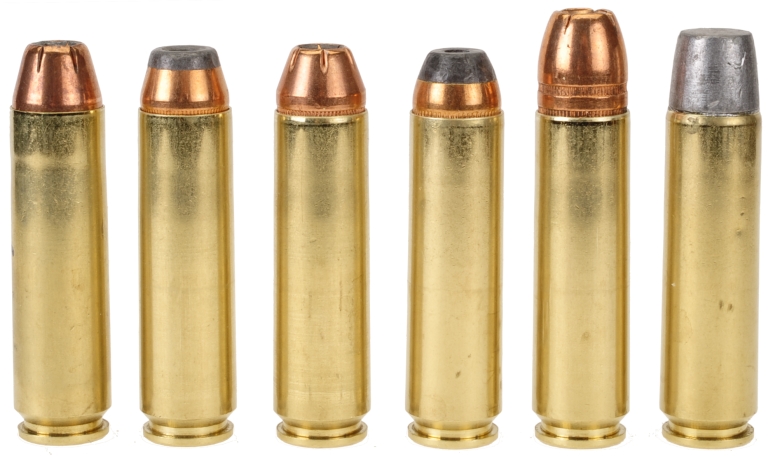
Email Notification